-
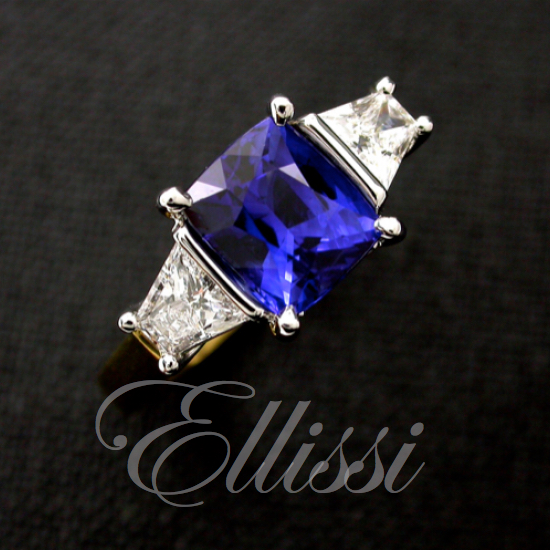
“Cornflower” Ceylon Sapphire and Trapezoid Diamond Ring.
Style Number: EL2131 -

“Elise” Cushion Brilliant Halo Ring
Style Number: E2055 -
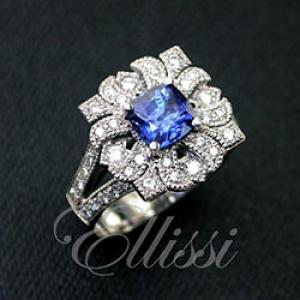
“Manola” Ceylon Sapphire diamond ring, antique style.
Style Number: E7667 -
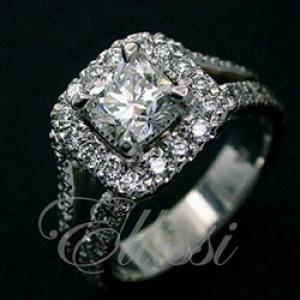
“Astére” Cushion brilliant cut halo cluster.
Style Number: E4694 -
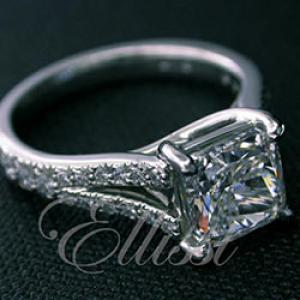
“Anna” Platinum Cushion Brilliant solitaire.
Style Number: E5047 -
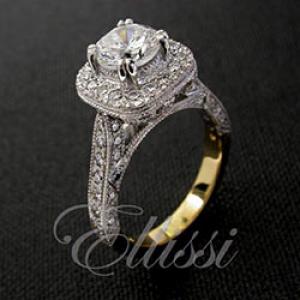
“Honora” Round brilliant diamond in cushion halo.
Style Number: E5675 -
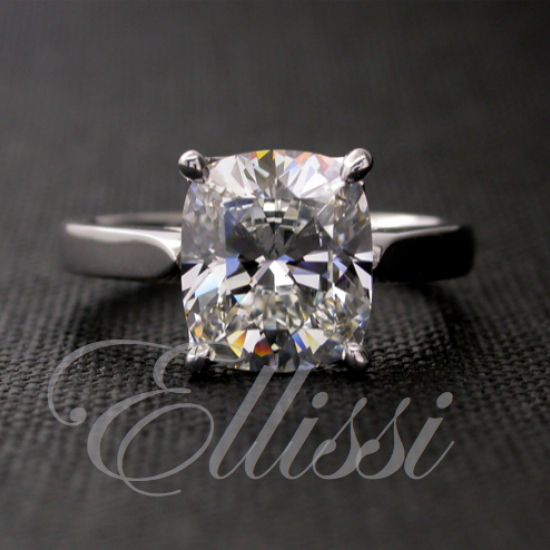
“Celeste” Solitaire Cushion 1.78 ct
Style Number: E9394 -
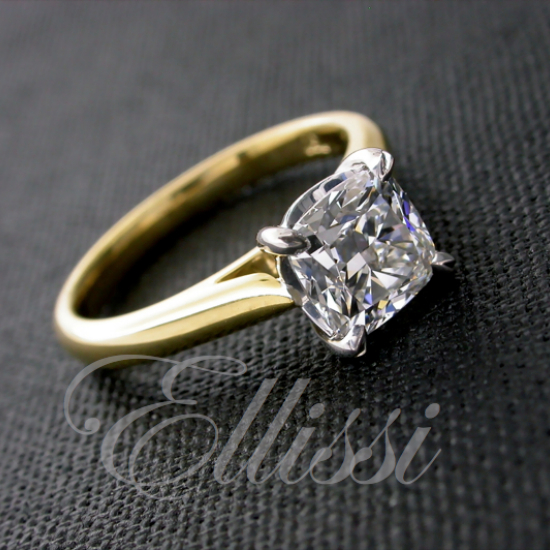
“Aina” Cushion diamond 1.04 ct
Style Number: E9414 -
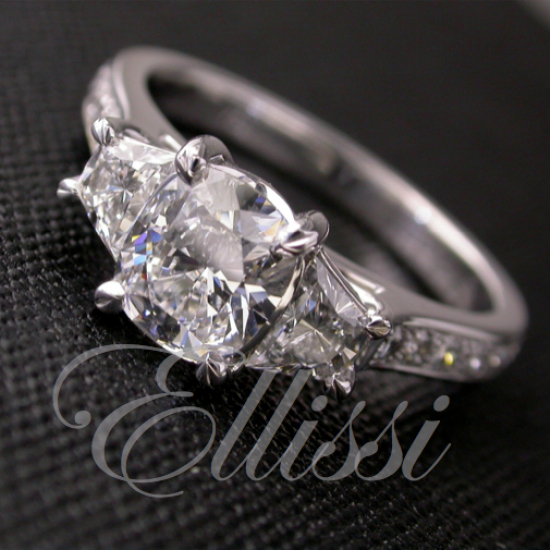
“Tribuo” Trinity ring. Cushion and trapezoid diamonds
Style Number: E9554
Cushion cut engagement rings have been enormously popular for some time and will continue to be so for many years to come. Cushion cut diamonds are a soft square shape with rounded corners, a bit like the cushions on a couch. The shape really lends itself to many ring designs.
Cushion cut diamonds are a nice balance for those who like the squarer diamond shapes and ring designs, but don’t want the sharp corners of the princess cut. The Cushion cut is kind of halfway between the round brilliant and princess or radiant cut. Cushion cuts that have a slightly longer ratio can have a little bit of the oval diamond look as well.
Whilst the outer external shape of a cushion cut diamond is fairly uniform across all cushion cuts (although poor cuts can be oddly shaped), the appearance of the faceting arrangement can vary enormously between different diamonds – some cuts are great, others not so good at all. The most common cut type is called a “Cushion Modified Brilliant”. Around 98 % of all cushion diamonds fall into this category, and it covers a very broad range of cut types. A “cushion modified brilliant” cut could have more than 100 facets or less than 50. They are a real mixed bag. Most commonly the number of facets would be in the range of 57 – 71. However, the layout of cushion modified brilliant cuts can vary greatly – ranging from fantastic to average. Some are fairly dull and lifeless and others that are better cut are at the top of the tree.
The cushion cut diamond is one of the most varied of the “fancy cut” diamond shapes. When you view our custom made cushion cut engagement rings on the ellissi site you will be a little spoilt. This is because, as with all diamonds we select for our engagement rings, we seek out the very best cushion cuts that are available. Most of the cushions shown on our website are set with “Cushion Brilliant” cut diamonds. This cushion type is the highest standard of cut and only around 2 % of cushion diamonds are this good. This is due to the cushion brilliant having the closest faceting arrangement to the Round Brilliant cut, which is regarded as the very best cut for refraction. So any diamond that comes close to that is going to be far better that the rough, lumpy cushion cut diamonds that we often come across in cushion cut engagement rings in the general market place.
Cushion cut diamonds can be what we call “square” meaning that the length and width are equal. They can also be longer in one direction, making them more of a rectangular and even like an oval looking diamond in some cases. No matter which shape an engagement ring design calls for, the cut should be given very very careful consideration. This is, after all, the centre piece of the engagement ring and if it is a badly cut diamond, this will affect the look of the ring.
Many of the standard “cushion modified brilliant” cuts that you get are very poorly cut, and suffer from what is called the “crushed ice” look. In this type of diamond cut, the angles of the facets on the back of the diamond (the pavilion) are too steep, meaning that not only will the cushion diamond be lumpier at the back than the better cut options, and therefore often smaller looking from the top, but that the facets create multiple reflections of each other, back and forth within the diamond. This gives it the appearance of “crushed ice” inside the diamond. It can look as if it is fractured or like crinkled up tin foil – very undesirable in a diamond. This variant of the cut should be avoided, as not only does it not look good in the engagement ring, it can also make the diamond you have bought look darker and more tinted, so a G grade could have the look of and H or less, when set into the engagement ring.
Another problem that some of the standard “cushion modified brilliant” cut diamonds have is what is called a “window” effect. It is the reverse of the “crushed ice” problem in that it happens when a diamond cut has either too few facets on the rear of the diamond and/or a quite shallow pavilion angle. The diamond’s total height for it’s weight may be what is required, because the crown could still be a little on the high side. The result of this is that when you look into the diamond, you do not get a good refractive break up of light. Basically, you can almost see straight through the diamond, which can look like a dull or dark area in the diamond. This can create a “window” in the diamond that allows some of the light to be lost. It can mean that when you look at the engagement ring, the setting can be seen through the diamond, again meaning a lifeless look to the diamond and engagement ring.
In order to look great, cushion cut diamonds (as with all diamonds) need to display a good balance in the quality elements. Cushion cuts all differ to some extent, but finding a diamond that is in the top 10 % in terms of how it is cut, rather that the heaviest diamond that is so poorly cut that it is in the bottom 10 % of available cushions, is crucial if you want a great looking diamond in your engagement ring. Buying a diamond based on its weight alone is a great mistake. At Ellissi we work hard to source the best cut diamonds available. The results of our efforts can be seen in the following pages when you look at some of the cushion cut engagement rings we have made over the years.


